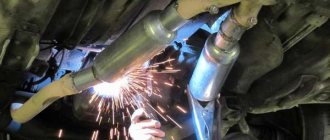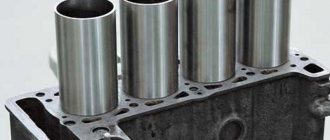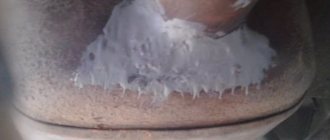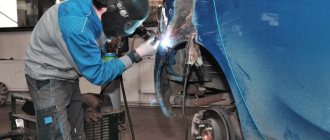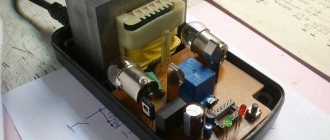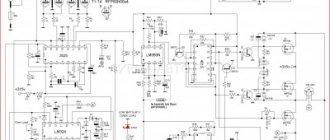Massive cylinder housings are made from cast iron. This durable material has one significant drawback - it is very fragile. When struck, cracks form on it or the wall is completely destroyed. Due to small defects, service stations often suggest replacing the engine, although cracks can be effectively eliminated by welding ICE (internal combustion engine) blocks.
Is it possible to repair a cast-iron engine block yourself, and how to do it correctly, professionals tell you. They have proven in practice that in a garage, having a welding machine and working skills, it is possible to restore the tightness of the metal and its operating parameters. This engine has been in use for many years.
How to weld a cast iron engine block
Massive cylinder housings are made from cast iron. This durable material has one significant drawback - it is very fragile.
When struck, cracks form on it or the wall is completely destroyed. Due to small defects, service stations often suggest replacing the engine, although cracks can be effectively eliminated by welding ICE (internal combustion engine) blocks. Is it possible to repair a cast-iron engine block yourself, and how to do it correctly, professionals tell us. They have proven in practice that in a garage, having a welding machine and working skills, it is possible to restore the tightness of the metal and its operating parameters. This engine has been in use for many years.
Properties and weldability of cast iron
Due to the increased carbon content in welds, pores filled with carbon monoxide are formed. Voids reduce the mechanical strength of the cast iron structure, in which cracks appear. The metal is characterized by rapid cooling. Due to temperature differences, internal stresses arise and various modifications of crystal lattices are formed, leading to the appearance of faults. Welding requires special electrodes and requires uniform heating and cooling of the cylinder block.
We recommend that you read
How to weld exhaust manifolds
Methods for welding a cast iron cylinder block
To reliably eliminate small defects in the form of cracks, there are several effective methods. Difficulties arise when repairing aluminum alloys. This is due to a change in the properties of the metal when heated, the formation of a refractory oxide film. The aluminum engine block requires some gas welding skills. If cracks appear in cast iron, welding of the cast iron block is carried out in three ways:
- when heating everything;
- fragmentary heating of the repaired area, used when it is impossible to completely heat the overall body;
- electric welding on a cold surface, this method is most popular due to the ease of execution and the quality of sealing cracks.
Hot welding
According to the technology, the part to be welded must be heated to +600-700°C, this is done in special furnaces and furnaces. Craftsmen carry out the process in casings with an asbestos layer. Gas burners are used for this. When heated, the metal retains its plasticity and viscosity. It is better welded by the electric arc liquid bath method using electrodes of the MNCh-2, OMCh-1, OMCh-2, OZCh-2, OZZHN-1, TsCh-4 brands.
The method is used to seal cracks in hard-to-reach places. Special holes are made in the casing to seal defects. Heating is carried out slowly, since a sharp temperature change deteriorates the quality of cast iron.
Cold welding without preheating the block
The process of eliminating cracks is carried out using three methods:
- electric arc using flux, cast iron filler rods, graphite or carbon electrodes;
- manually using a protective atmosphere (argon), the electrode must contain graphitizers that reduce the fragility of the weld;
- semi-automatic with flux-cored filler wire in a carbon dioxide atmosphere. The cold method of metal repair is more economical; it involves heating the area in the weld area to a temperature of + 80°C.
Alternative methods
To begin with, minor cracks can also be repaired using epoxy paste and fiberglass. Before starting work, the metal surface must be thoroughly degreased. Layers of paste and fiberglass alternate when applied, the last layer should be epoxy.
Among the most popular technologies today, it is also worth noting a solution called SEAL-LOCK. The advantages of this method include the absence of the need to dismantle the engine. The method is suitable for repairing serious holes or cracks in the cylinder block. Also, repairs do not require the use of a welding machine.
The method is based on filling the crack with a special layer of soft metal, which as a result is securely bonded to the surface of the part being restored.
- The crack is localized, after which the edges of the split are drilled. Next, holes are drilled across the crack at the pitch established by the technology. Cable ties are inserted into these holes to tie both edges of the crack. The staples are selected according to the type of split, as they can have different lengths and differ in shape.
- Next, a hole is drilled in the space between the installed brackets, after which the conical thread is cut using a special tap. After this, it is necessary to treat the resulting hole with a composition to remove the oxide film. Then a cone plug is screwed into the machined threaded hole with little force, the material of which is in active contact with the metal of the part being repaired.
- Next, the part of the plug that rises above the plane needs to be filed a little, after which screwing is carried out with great force, which is created by a special tool. Under such force, the soft plug will break in the place where the cut was previously made. Protruding residues are additionally sanded.
- The next step is to drill the next hole. This hole is drilled so as to achieve partial overlap of the previous threaded hole with the plug installed. The repair procedure involves filling the entire crack with plugs.
Riveting the seam eliminates possible voids and also accelerates the diffusion of rivet materials and the part. The result will be the appearance of a plastic seam that has a strong connection with the surface. This seam has a number of advantages compared to a welded seam:
- does not suffer from temperature changes;
- is able to maintain integrity under operating conditions at high temperatures;
- does not receive significant stress;
As for installing large patches that can literally “seal” a cracked engine block or cylinder head, then the solution method according to the implementation scheme is similar to that described above. You will need to cut and fit a metal patch, after which it is installed by filling the entire perimeter with ties and cone plugs. Subsequent testing of the finished seam for tightness is carried out using crimping under a pressure of about 6 atmospheres.
Source
Welding technology
Now let's talk in detail about how to weld a crack with your own hands. Parts are pressed out at the site of damage. The defect is discovered after hydrotesting; for convenience, the crack is marked with a thick chalk solution. 5 mm holes are drilled at the ends.
To weld a cast iron block you will need:
- welding machine with current regulator or inverter;
- 2–3 electrodes, it is better to purchase universal Zeller 855;
- chamfering tool;
- brush and hammer for cleaning the seam and removing scale.
The crack must be welded using the following technology:
- The seam area is cleaned to a shine and degreased.
- Flux is applied to both sides of the edges, protecting the cast iron from heating.
- The repair area is heated by a gas burner evenly and gradually, the direction of movement is along the crack.
- The seam is formed in small sections, up to 15 cm long per pass.
- The resulting seam is heated for about five minutes so that the metal cools slowly. When subjected to sudden cooling, it will become brittle and will not withstand the workload.
- The scale is carefully knocked off, and after a visual inspection the joint is well cleaned, especially if the chip is in contact with other parts.
By forging each roller separately, you can immediately eliminate possible defects.
When a defect is found on the engine block, do not rush to replace it. It is better to consult with specialists whether it makes sense to undertake repairs. It is possible to weld a block crack with cold metal in a garage. You need at least basic welding skills to get the job done accurately. Some service stations provide welding services for internal combustion engine blocks; this is much more expedient and cheaper than completely replacing the engine.
The need to weld the cylinder block arises when cracks appear on it. A large number of blocks are made by casting cast iron. Cast iron is a fairly strong and hard material, lends itself well to casting and has a low melting point compared to steel. The negative side of the material is fragility and low viscosity. In this regard, the most common malfunction of blocks is the appearance of cracks.
Rice. 1. Cylinder block
Bottom line
When a defect is found on the engine block, do not rush to replace it. It is better to consult with specialists whether it makes sense to undertake repairs. It is possible to weld a block crack with cold metal in a garage. You need at least basic welding skills to get the job done accurately. Some service stations provide welding services for internal combustion engine blocks; this is much more expedient and cheaper than completely replacing the engine.
Any car has a cast cylinder block. The main malfunction of these motor parts is the appearance of cracks, which can be eliminated by welding. How to weld a cast iron car engine block? This procedure is quite complicated. When performing welding work, it is necessary to achieve both the tightness of the product and the restoration of its physical characteristics.
The engine block is the most important component of any modern car. There are many work processes associated with this element that affect the speed and power of the vehicle. Due to its low melting point, cast iron is used to produce this element. Using cast iron, you can cast parts of varying design complexity, even with the smallest elements.
It is important to understand! Welding cast iron car cylinder blocks is a rather complex job, during which it is necessary not only to achieve a tight connection, but also to restore the physical characteristics of the product.
Preparing the cylinder block for welding
Before carrying out welding work to repair the unit, it is necessary to thoroughly clean it of dirt, oil and other contaminants. Cracks and discontinuities identified on the block must be marked with chalk or other convenient means.
In order to avoid the growth of cracks, its edges must be drilled. Small cracks up to 5 mm can be welded without cutting the edges. Deeper cracks must be made with cutting edges.
Rice. 2. Drilling cracks
The hole must not be made through, but only until a gap appears along the entire length of the crack. The crack prepared for welding should resemble a joint with a V-shaped bevel of the edges. This is done so that during welding all gases and impurities contained in the welding materials and base metal can escape to the surface of the weld.
Bottom line
When a defect is found on the engine block, do not rush to replace it. It is better to consult with specialists whether it makes sense to undertake repairs. It is possible to weld a block crack with cold metal in a garage. You need at least basic welding skills to get the job done accurately. Some service stations provide welding services for internal combustion engine blocks; this is much more expedient and cheaper than completely replacing the engine.
Sources used:
- https://svarkaprosto.ru/tehnologii/svarka-chugunnogo-bloka-dvigatelya
- https://electrod.biz/varim/vyipolnyaem-svarku-chugunnogo-bloka-dvigatelya.html
- https://osvarke.net/svarka-avtomobilej/svarka-bloka-cilindrov-iz-chuguna/
- https://dorpex.ru/kuzov/svarka/svarka-chugunnogo-bloka-dvigatelya
Video on welding cast iron cylinder blocks using the argon arc method
In the next video, the author welds a crack on a block using the argon arc method with a non-consumable electrode.
How can you weld or solder a cast-iron engine block?) It may seem funny, but some people say that it’s possible, some tricks the Chinese are selling that can be soldered. But I would like to know your opinion and advice?
Such a thing, on the engine block where the bend of the joint with the oil pan is cracked, oil is leaking from there.
The crack is due to the fact that the previous owner, when removing the pallet, hit it past with a hammer, the mark of the chisel is clearly visible)))
We tried it with sealant, it’s enough for about 3-4 thousand. I’m afraid that this crack won’t go any further.
Welding an engine block with argon - does it make sense?
There are different types of car engine repairs. You can simply use recovery after the breakdown of some internal and peripheral parts. And it is possible to restore after serious damage. These types of breakdowns include cracks in the cylinder block, chips in functional areas of the unit and various other features. With such breakdowns, it is simply impossible to operate the power unit, otherwise it may rupture during the process of pressurizing the chambers. There are two options for getting out of the situation. The first is replacing the damaged part. You need to select a suitable version of the engine block or a specific part; this can be done by disassembling, but with the help of a good specialist. This way you can make a really high-quality selection and buy reliable spare parts for restoration.
The second option is argon welding. Many owners of cars with damaged power units perform argon welding. This is a fairly high-quality process of connecting aluminum alloy parts to each other. However, this is not the best solution for load-bearing main engine parts. If the cylinder block is cracked, it is better to buy a new one. Here welding will not be an appropriate solution to the problem. This is one of the most expensive options for car breakdowns, but sometimes you can get by with more or less affordable costs. It all depends on the type and location of the crack, as well as a number of other features. It is important to complete all tasks really efficiently in order to restore all parts and obtain high reliability of the power unit.
Features of welding engine blocks made of cast iron
There are many methods for welding metals, but in order to obtain the most reliable connection of individual parts, it is necessary to use proven technologies that can guarantee the effective performance of welding work.
Welding technology
Regardless of the conditions under which a cast iron cylinder block is welded, it is necessary to strictly follow the following requirements for performing this type of work:
- Using a metal brush, first thoroughly clean the surface of the product (until it shines).
- To remove the oxidizing film and various chemical deposits, the cleaned surface is degreased with special compounds.
- The required flux is selected and laid out along the edge to be welded.
- At the next stage, the metal is heated to the required temperature using a gas burner. This will take a few minutes, but it is not recommended to start welding right away.
- The metal can be joined after it reaches the specified temperature. The cylinder block is welded in small sections - up to approximately 15 cm in one pass.
- After creating the seam, the metal must be heated for a few more minutes, gradually reducing the temperature. Rapid cooling of the part or sudden temperature changes should not be allowed.
- The created welded joints must be checked: in production this procedure is carried out using special methods, in domestic conditions a visual inspection is carried out.
Cracked car engine block
There are three options for welding cracks in cast iron cylinder blocks:
- heating the entire product;
- heating only individual sections of it where cracks have formed;
- cold welding of a product without preheating.
If, after welding the crack, the surface of the cylinder block comes into contact with other engine parts during operation, it is subject to additional processing. Excess welding metal is removed using sandpaper, a file, or an abrasive.
Hot welding
Heating of the entire engine structural element is carried out during welding using oxygen and acetylene. The connection is made by forming an electric arc using steel or cast iron electrodes with a special coating. The product is slowly heated to 600–650 degrees, for which a steel casing with an asbestos gasket is used. This technique is used to weld cracks in hard-to-reach areas of the part.
Important! Only an experienced welder can weld a cast-iron car engine block properly. Unprofessional work can lead to complete failure of this part.
Source
Replacing the cylinder block and abandoning welding is the right decision
Any welding, even by the most professional performer, will not be as high quality as installing a new cylinder block. When there is a crack in this unit, the component parts of the unit quickly break down and everything fails. Even with professional welding, it is impossible to maintain all factory dimensions down to the last micron. The cylinder block is replaced as follows:
- Based on the make and model of the engine, the specialist searches for spare parts, selects all peripheral parts that will also have to be changed, and forms a budget;
- Also added to this budget is the cost of work, which each master evaluates in his own way, but it is better to contact a professional car service station;
- Next, the engine is disassembled, the problem and its effect on all other parts, such as pistons, connecting rods, rings and seals in the unit, are studied;
- a new cylinder block is installed, the necessary parts are assembled in the right place, and at each stage several checks are performed, which proves the quality of the part;
- After assembly, it is necessary to diagnose the power unit in different planes, then test drive the car with an understanding of all extraneous sounds and noises in the engine.
If a used cylinder block is being installed, special care must be taken during the engine testing and inspection processes. However, with professional selection of the part, no negative features of the operation of the power unit should arise. That is why replacement is the optimal process for such a breakdown. But welding is not always suitable, even if done professionally.
Additional Information
After completion of the work, the surfaces must be treated (for example, if any unit is being installed). In a workshop setting, a milling machine is used to level the plane; in a domestic situation, an angle grinder is used. At the same time, it is important not to damage the mating surfaces with high precision processing (for example, for installing a clutch bell, front cover or head).
We recommend that you read
How to solder a cooling radiator yourself
Welding an automobile cylinder block requires a highly qualified worker. Mistakes made lead to a decrease in the strength of the assembly; with cyclic temperature changes (the part warms up to +90°...+95°C and cools down to ambient temperature), new cracks may appear. In case of a large area of damage, it is possible to install patches from a sheet of steel, which are welded into cast iron. The decision on the method of restoration and the feasibility of repair is made by the master, based on the qualifications and equipment available.
Modern technologies for welding aluminum with argon
There are many processes in a modern car that can be performed using argon. It is quite easy to restore wheels made of light alloy materials using this technology. But the basis is the repair of engine housings and blocks, as well as gearboxes. In the process of welding engine elements with argon, the following important tasks are performed, which are performed only by specialists:
- research and preparation of each element for welding work, cleaning the surface and searching for additional material if necessary, to seal the hole;
- preparing the site according to safety measures, we are talking about welding at very high temperatures with a certain risk of damage to people and objects around;
- implementation of the welding process itself, with careful supervision of all surrounding parts, very careful execution of the main necessary task;
- the use of additional compounds for surface treatment to avoid its oxidation and other unpleasant processes after all welding work has been completed;
- cleaning the welding site if necessary to obtain a smooth surface that meets the manufacturer’s technological requirements for operation.
How to find a crack
The following methods are used to identify cracks:
- ultrasonic detection method;
- use of magnetically sensitive equipment;
- pneumatic crimping method;
- searching for cracks using hydraulic control;
In practice, crack detection in many car repair shops is carried out by pumping air or water into the faulty engine element. In the case of air, the part is additionally immersed in a bath and defects are found by bubbles. If water is pumped into the element, then the need for immersion is eliminated, since cracks are diagnosed by liquid seepage.
To determine the exact boundaries of the crack, a pair of magnets are attached to both sides of the split, and the space between the magnets is filled with special conductive filings. The presence of a crack will cause the magnetic field lines to break, causing sawdust to partially cluster on the crack surface. This method allows you to clearly identify a crack in the cylinder block or cylinder head.
When does it not make sense to weld with argon?
Often during the operation of a car, it becomes necessary to change the sensor in the engine housing or spark plugs. It may well turn out that these elements are too tight. In this case, the master or owner may apply excessive force and simply break off a piece of the unit. If this was done at the place where the spark plug was installed, you will have to buy a new block. When attempting to weld, the following processes will occur:
- the technician will restore the damaged area as carefully as possible, but the seat diameter can no longer be made ideal for the candle;
- you can use the option of melting, and then drilling and cutting the required thread, but it is also impossible to maintain the required installation height of the candle;
- if we are talking about a sensor, it is also simply melted and not used in the future, because otherwise you will have to perform incredibly difficult work to restore the installation site;
- if there is a crack in the body itself from the outside, you can be sure that there is a crack on the inside, so it can only be welded in certain situations that a specialist knows about;
- unprofessional argon welding will bring big problems, in this case it is better not to do any work with a broken cylinder block, but simply buy a new one.
Welding with an argon mixture occurs using a tungsten electrode, which heats up to a temperature of about 4000 degrees at maximum mode. This requires not only increased caution, but also fairly high professionalism. Simply place the electrode in the wrong spot, and it will simply make another hole instead of welding the necessary elements of your engine.
Welding an engine with argon and subsequent sale - we are clogging up the car market
The attitude of Russian people towards the automobile market is simply surprising. Many people sell their cars, realizing that in two days they will have an irreparable problem and will have to replace expensive components and assemblies. It is enough to simply understand how much anger and hatred the buyer will feel towards you, so as not to make such a mistake. If the cylinder block in your car is cracked, you should work around the situation as follows:
- replace the unit with a used, but high-quality one, get more money from the leisurely sale of the car without special discounts and with confidence in the high quality of the car;
- replace the cylinder block with a new one and continue driving the car without selling it, enjoying the fairly high quality of the revived power unit;
- indicate in the sales advertisement that the car is damaged, there are certain problems that can be solved for a certain amount, which will result in a discount;
- when meeting with a potential buyer, honestly tell them that there is a problem with the engine that needs to be solved urgently, and reveal your readiness to concede the selling price;
- weld the engine with argon, and then, when selling, honestly admit this and show the place of welding, this will relieve you of any responsibility for the further behavior of the unit.
It is often possible to gain no more than a few hundred dollars by concealing all the details of car repairs from the buyer. And this amount is definitely not worth it to continue to clog up the automotive market with not entirely suitable equipment. Such decisions can also be disastrous for you if the buyer decides to look into the whole situation. However, for now there is no need to expect a civilized market in Russia. We invite you to look at more or less high-quality restoration of microcracks using argon:
Let's sum it up
As you can see, the cylinder block is welded with argon most often for sale. This is not the most reliable option for repairing a power plant. But there are masters who can do everything quite efficiently. Often, after a visit to them, the owners decide to sell the car, as they are constantly worried about the presence of handicraft interference in the operation of the engine. Any sound becomes scary, it seems that the engine is now going to shatter into small pieces. Therefore, when repairing a car for your own further use, it is much better and easier to perform a normal repair with replacement of the cylinder block.
When making repairs for sale, it is better to refuse any work altogether, simply discounting the price to the buyer for the amount of repair work. If the new owner wants to cook the engine with argon, that will be his problem. You will come out of this situation fairly honestly with an untarnished reputation. You should not carry out cheap argon welding in a garage car service, and then quickly go to the car market in the hope of selling the car and forgetting about all these problems. Through mutual scams, car owners have already made the car market a dangerous place where they can lose all their money. How do you feel about repairing unit housings and gearboxes using argon welding?
Cooking cast iron semi-automatically
Cast iron is widely used to make pulleys, blocks, and commutators. It has good casting properties, which makes it possible to produce products of various shapes from it. But this material also has disadvantages - it is quite fragile. Impacts often cause chipping of sides on pulleys or cracks in pipes. To correct the situation and restore the product, they resort to various methods of joining metals. One of them is semi-automatic welding of cast iron. What are the features of this method? How many options are there for using a semi-automatic machine? What supplies are suitable?
Why is it difficult to cook cast iron?
The question of whether it is possible to cook cast iron with a semi-automatic machine worries many people for good reason. The connection of the sides of this material does have a number of specific features:
- The high fluidity of cast iron manifests itself when forming a seam where the weld pool is too liquid. Because of this, it is more difficult to visually control the quality of compound formation. When trying to weld thin plates of cast iron, a common defect is metal burning and droplets leaking onto the opposite side. To prevent these undesirable manifestations, graphite pads are used to support the plates on the reverse side. You can learn how to form a seam when the metal has high fluidity by practicing on training products made of similar alloys.
- The second difficulty is the low melting point of the material. Due to the high temperature from the electric arc, the cast iron in the welding zone quickly overheats. As a result, upon cooling, microcracks form between the base and superimposed metal. Overheating of additional impurities in cast iron (manganese, silicon) leads to the appearance of cementites in the weld structure, which complicates subsequent processing of the joint with grinding tools. To prevent these defects, they resort to preheating the material and a gradual cooling procedure for the product.
- It is difficult to weld cast iron efficiently due to the large number of pores that appear as a result of the release of carbon when interacting with oxygen. Even with subsequent processing, the seam may have an unattractive appearance and poor resistance to fracture. To protect the connection, copper-plated wire is used, and the work is carried out in an inert gas environment. A prerequisite for welding cast iron is the flux content in the wire.
Features of the material used for the manufacture of cylinder blocks
Car engine blocks are usually cast from cast iron.
This material is an alloy of iron and carbon, the content of which is 2.14%. This negatively affects the quality of the connection. Main difficulties of the process:
- formation of pores and cracks;
- the appearance of hardened structures during processing, the tool used quickly becomes dull;
- As a result of overheating, the thin material crumbles.
Cast iron may differ in composition:
- gray cast iron is a malleable, high-strength material, easy to process, limited weldability;
- white cast iron is a fairly hard and brittle material that can be ground, but cannot be welded.
Welding methods
Depending on the purpose of the product, three types of semi-automatic welding of cast iron are used. They differ in the speed of work completion and material costs.
Cold method
This is the easiest way to quickly join high carbon iron plates. Welding is performed immediately on a material whose temperature is equal to the ambient temperature. The cold method is used on non-critical butt joints that will not be subject to loads. The method is ideal for surfacing worn surfaces and machine parts made of cast iron. Thanks to the continuous wire feed, you can quickly arc and complete a large amount of work in a short time. As you can see in the video on semi-automatic welding of cast iron, the result from the cold method is satisfactory.
Semi-hot method
The semi-hot welding process differs from the previous one in that the cast iron workpieces are preheated to a temperature of 350 degrees. For this purpose, forges are used, in which the heat from the coals creates the necessary conditions. This preparation contributes to a more gentle reaction of cast iron to the high temperature of the electric arc, resulting in the formation of fewer cracks in the heat-affected zone. The technology is used on products that experience some stress during operation.
Hot method
This method is used where a high-quality connection is needed that has high tear and fracture resistance. The product heats up to a temperature of 600 degrees. For this purpose, devices producing induction currents are used. The cables are connected to the cast iron part, and a special measuring device signals the temperature reached. After this, semi-automatic welding is performed. To minimize cracks, after welding the product is left in the ash until it cools completely. Depending on the thickness of the structure, this period can reach 24 hours. The method allows you to weld cast iron reliably and efficiently, but is characterized by high time costs and the need for additional equipment.
Repairing cracks using welding
It should be noted that splits must be eliminated in strict accordance with all recommendations. Residual mechanical stresses in the weld area can lead to damage to its integrity and the need for repeated repairs.
A cast iron block is repaired by drilling out the ends of the crack and then grinding the entire length of the split at a 90-degree angle. Drilling is necessary to prevent further spread. As for welding, at the initial stage the cylinder block is heated to 650 degrees Celsius. After this, a continuous seam is applied using a cast iron-copper rod and flux. The final stage is the gradual cooling of the part, which requires a special heating cabinet.
Equipment and consumables
To obtain good joints from difficult-to-weld alloys, any semi-automatic machines are used. The main criteria are compliance with the maximum current of the device required to penetrate a specific thickness of metal. The adjustable current and wire feed speed parameters are similar to welding conventional steel.
Wire is used with specialized markings: PP ANCH-1, as well as with numbers 2 and 3. Each number is intended for a specific method (cold, semi-hot, hot). The wire has a tubular structure and contains flux powder inside, which protects the weld pool from exposure to oxygen. Enrichment of the applied metal with special impurities promotes high tensile strength of the seam and tensile strength. Thanks to Anch wire, it is possible not only to eliminate minor defects in cast iron, but also to produce full-fledged seams that firmly connect this specific metal.
To weld cast iron, a gas supply is used, which additionally protects the weld pool. Depending on the purpose of the product and the amount of impurities in the alloy, you can use carbon dioxide in its pure form or its mixture with argon, where the latter will be 80%. The flow rate from the pressure gauge to the burner should be 6-11 liters. This will optimally protect the molten metal from displacing carbon.
Semi-automatic welding technology
When welding cast iron with a semi-automatic machine, regardless of the temperature conditions, it is necessary to properly prepare the material. If you need to weld a crack, it is important to make a preliminary cut with a grinder along the entire split line. This will allow the filler material to be fused deeper. It is recommended to drill the edges of the cracks to limit its continuation.
If the thickness of the plates is more than 5 mm, then cutting the edges at 45-60 degrees is necessary. When working with thin sheets (up to 3 mm), graphite preforming is used to prevent burns. The first seam is made with a smooth pass without oscillatory movements. The burner can be operated from top to bottom or from right to left, tilted 50 degrees. The distance between the nozzle and the surface is maintained within 6-8 mm. It is important that the welder can see the end of the wire.
It is rarely possible to brew cast iron the first time, so it is recommended to go through the seam in several layers. Subsequent passes can be made with transverse vibrations in order to bind the base and deposit metal more widely. After welding is completed, it is necessary to separate the slag formed during combustion of the flux-cored wire and ensure the quality of the result.
Semi-automatic welding of cast iron is quite popular due to its high productivity and good quality of connections. By choosing the right wire and temperature conditions, you can get a reliable connection on this “capricious” material.
How to cook cast iron with an inverter and a consumable electrode
Welding cast iron using an inverter and a consumable electrode is most often carried out using the cold method. Important components of successful work are: the correct choice of electrode and optimal welding modes.
Electrodes OZCH-3
The performer must make the connection with special electrodes containing nickel and/or copper:
- OZZHN-1;
- OZCh-2;
- OZCh-3;
- OZCh-4;
- OZCh-6;
- MNC-2;
- TsCh-4.
Recommended welding modes for some of the listed brands:
| Electrode brand | Current strength for an electrode with a diameter of 3 mm. | Current strength for an electrode with a diameter of 4 mm. | Current strength for an electrode with a diameter of 5 mm. | Current strength for an electrode with a diameter of 6 mm. |
| TsCh-4 | 65-80 | 90-120 | 130-150 | – |
| OZCH-2 | 90-110 | 120-140 | 160-190 | 220-250 |
| OZZHN-1 | 100-120 | 130-150 | 160-180 | – |
| MNC-2 | 90-110 | 120-140 | 160-190 | 210-230 |
The following technological features should also be highlighted:
- the length of one continuous seam should not be 30-50 mm;
- frequent breaks in the welding process will help eliminate the possibility of overheating; temperatures above 80°C are unacceptable;
- polarity is reversed.
This welding method can be performed in two ways: using studs and in layers.
1. The studs are equipped with threads, which allows them to be screwed into the edges of the product being welded. The studs should be staggered/staggered to prevent overheating during welding. The dimensions of the studs depend on the thickness of the workpiece; when selecting them, you should rely on the following recommendations:
- diameter – 0.3-0.4 product thickness, but not more than 12 mm;
- screwing depth – 1.5 times the diameter of the stud, but not more than half the thickness of the product;
- the height of the protruding part of the pin is 0.75-1.2 times the diameter.
After installing the studs, you can start welding. Metal is deposited around each pin, layer by layer. Then the performer needs to weld the space between the studs, which remains untouched, and make one or more connecting seams.
2. Multi-layer welding is performed after cutting the edges. The presence of sharp corners is not allowed. Surfacing should be done from the edges. The first layer is the main one, so during its deposition you need to carefully monitor the welding mode. Each subsequent layer, except the first and facing ones, must be forged with a hammer, without cooling.
Video
The following video demonstrates the Zeller 855 cast iron electrode, but from the video you can see how welding is done.
This information will help the contractor learn how to cook cast iron with an inverter using electrodes on cast iron, and easily carry out the connection work.
Welding with conventional electrodes
In order to save money, you can use ordinary (steel) consumables instead of special ones. General purpose electrodes have a more affordable price. The technology of multilayer welding with conventional rods is practically no different from the method discussed above, which uses special rods coated with non-ferrous metals. The stages of work are similar. The only difference is that the layers following the first are deposited not with a special electrode, but with a regular one.
Attention! Welding cast iron with electrodes not intended for this purpose is possible, but we do not recommend using it in any critical connections! This information is provided only for welding for experimental purposes.
Welding with cast iron electrodes
This welding method can be carried out using a cold or semi-hot method. A little preheating will improve the structure of the weld metal.
Cast iron electrodes are cast rods coated with coating, used to correct defects in cast iron. This type of consumables includes the following brands: MNCh-1; OZCh-1; OZB-2M.
Welding is carried out using direct and alternating current. The current value is determined as follows: 50-60 A per 1 mm. electrode rod. [ads-pc-3][ads-mob-3]
